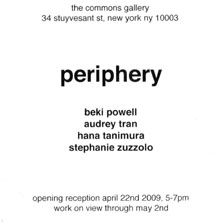 I recently went to Audrey Tran’s senior Art Thesis named Periphery and I talked to her about her piece which were essentially rows of saw grass arranged to be aesthetically pleasing and interesting to the eyes. She mentioned that the idea behind it is the grass growing in the cracks of the pavement. Now there are a slew of things that this evokes. For one, it reminds the viewer of the magnificent glory of nature even in it’s smallest offspring. Additionally it tells of the wily tenacity organic creatures and plants have, which strive to live and compete. Finally, and probably most starkly, this idea tells us of the transience of humanity’s impact on nature. Though we may be able to alter the climate of the planet, punch holes in the ozone and cause the greatest extinction level event since the dinosaurs were wiped from the planet, our planet will adjust, and it will do so without us. After we are gone, our steel will rust, our monuments crumble. Saw grass will poke through our concrete in no time at all.
I recently went to Audrey Tran’s senior Art Thesis named Periphery and I talked to her about her piece which were essentially rows of saw grass arranged to be aesthetically pleasing and interesting to the eyes. She mentioned that the idea behind it is the grass growing in the cracks of the pavement. Now there are a slew of things that this evokes. For one, it reminds the viewer of the magnificent glory of nature even in it’s smallest offspring. Additionally it tells of the wily tenacity organic creatures and plants have, which strive to live and compete. Finally, and probably most starkly, this idea tells us of the transience of humanity’s impact on nature. Though we may be able to alter the climate of the planet, punch holes in the ozone and cause the greatest extinction level event since the dinosaurs were wiped from the planet, our planet will adjust, and it will do so without us. After we are gone, our steel will rust, our monuments crumble. Saw grass will poke through our concrete in no time at all.
In Audrey’s blog she covers lots of interesting pieces, which are indicative of (at least in some parts of our culture) an eco-conscious movement. Why is it that music has not caught on to this? I think for one, there is a certain element that appreciation for nature has already been explored by earlier musicians, whether it be Beethoven, Berlioz or Schumann and their works that are specifically referential to pastoral scenes. On the other hand, romantic painters (and writers) in the Americas also had a phase of depicting gorgeous landscapes (how is today’s eco-art different from that?). It is possible that because of the musical world’s inherent conservatism that we aren’t on the cutting edge. Despite these things, I refuse to believe our medium cannot be expressive in an eco-friendly manner. I think the problem possibly lies in the difference between today’s eco-conscious movement and yesteryear’s nature appreciators.
 The Romantics viewed nature in awe (the work of God), and to a certain extent these landscapes seemed immutable to them. They believed that there was no way humanity could even pock mark these sweeping scenes, it was beyond our means to affect. Today, with our new consciousness of wide ranging human impact on the earth whether it be global warming or mountain-top removal mining, this admiration borne out of the aesthetic and immutability of nature holds no ground. Instead, current eco-conscious art is borne out of the desire to be a good steward of the earth and protect the beauty that is left, partly out of admiration for the aesthetics but also out of the need for self-preservation. Visual art (like always) is leading the charge in this artistic movement and there seems to be no response from music at all.
The Romantics viewed nature in awe (the work of God), and to a certain extent these landscapes seemed immutable to them. They believed that there was no way humanity could even pock mark these sweeping scenes, it was beyond our means to affect. Today, with our new consciousness of wide ranging human impact on the earth whether it be global warming or mountain-top removal mining, this admiration borne out of the aesthetic and immutability of nature holds no ground. Instead, current eco-conscious art is borne out of the desire to be a good steward of the earth and protect the beauty that is left, partly out of admiration for the aesthetics but also out of the need for self-preservation. Visual art (like always) is leading the charge in this artistic movement and there seems to be no response from music at all.
I wrote the first movement of a viola concerto my junior year and each movement is supposed to evoke the feeling of being in a certain wondrous environment. I wanted the piece to represent how it felt to be in those places, rather than sound painting. This is where the trouble of being distinctly pro-environment in music lies. Without become obscurely referential (like writing satirical music based on the jingle of an environmentally offensive corporation) it becomes difficult to move beyond being simply admiring of nature, much like the pastoral romantics.
Maybe this isn’t such a bad thing, though, as being evocative of the feeling of say, The Red Woods of Yosemite (that is the subtitle to the first movement of my viola concerto) can help remind the audience the value of our single green-blue dot and all the places on it that we treasure.